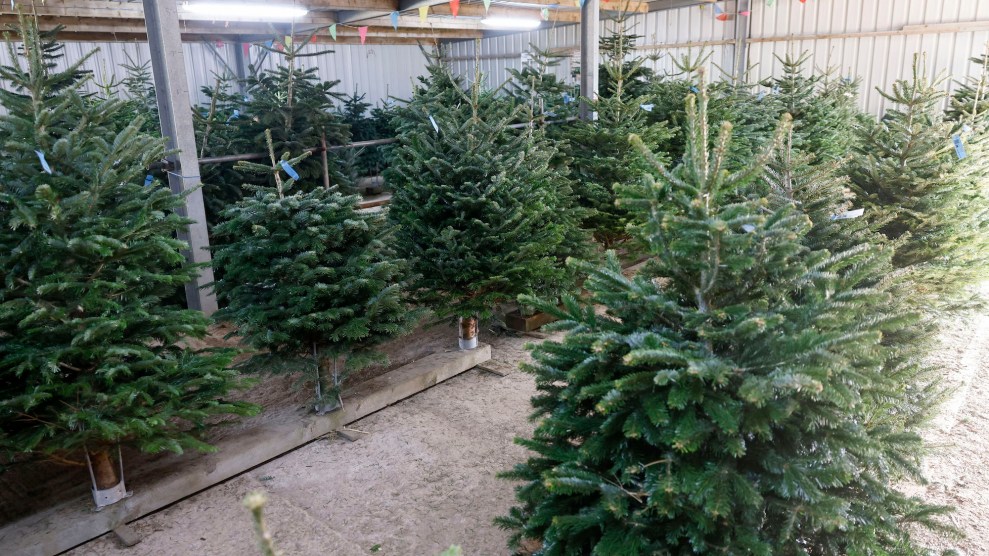
Jonathan Myers/Mirrorpix/Newscom/ZUMA
This story was originally published by High Country News and appears here as part of the Climate Desk collaboration.
Perhaps no single Christmas custom is more ubiquitous than putting up the Christmas tree. It originated in Eastern Europe more than 500 years ago, when people decorated evergreen trees with roses or apples as symbols of Eve and the Garden of Eden. Today, that ancient tradition is a booming business that employs nearly 100,000 people, garners close to $2 billion in revenue, and harvests 25 to 30 million natural Christmas trees annually—about 30 percent of them from the Pacific Northwest. Sales of real Christmas trees have increased by nearly 20 percent since 2020, though fake trees are booming, too.
Artificial trees have drawn criticism for the chemicals used in their manufacturing, as well as their carbon footprint. But live trees have drawbacks, too. One in particular—the agricultural chemicals and insecticides, fungicides, and herbicides used in tree farming—has drawn remarkably little attention, partly owing to a lack of research on the risk to consumers or farmworkers.
People who love their traditional green Christmas trees, even those worried about environmental impacts, seldom think about how those trees are grown. “I’ve used a fake tree for about 10 years,” said Denise Castro, from Eugene, Oregon. “Prior to that, I bought real trees. I never considered that there might be pesticides on trees.” After High Country News reached out to her, she started asking longtime friends if they’d thought about it. But pesticides were either something they hadn’t considered or weren’t particularly worried about. “You can count me in on this consensus,” said Michele Zemba. “Pesticides never crossed my mind when buying a real tree.”
Among the most common chemicals used by the industry are chlorothalonil, atrazine, glyphosate (better known as Roundup), and dimethoate, all of which have known impacts on human health. The half-life of some of these chemicals ranges from days to years, depending on the chemical involved and other factors. Over time, these pesticides accumulate in the environment, lingering in soil and groundwater and building up in plant and animal tissues—especially in human beings, who perch at the top of the food chain.
In Oregon, low levels of pesticides are commonly found in surface and drinking water. In 2021, researchers at Portland State University released data showing that forestry-related pesticides were present in Oregon’s coastal waters, a sign that they were flowing downstream from the state’s rivers. But it’s difficult to quantify any particular industry’s contribution to such widespread, low-level pollution over long periods of time—or to calculate the risks to consumers. Laura Masterson, an organic farmer and former Oregon Department of Agriculture board member, acknowledged that it’s another gap in the science. “We don’t really understand micro-dose impacts (of these chemicals) on health.”
Tree farmers say the pesticides help keep the industry in business by ensuring that they have a decent crop to get to market. “The reasons that growers are using herbicides are, number one, for seedling survival,” said Chal Landgren, former Oregon State University Extension Service Christmas tree specialist and a longtime Christmas tree farmer. Unlike other agricultural products, which are grown and harvested on an annual cycle, Christmas trees can take up to a decade to grow to a marketable height. Throughout that time, they’re susceptible to insects, fungi, and competing species, any of which can hinder growth or ruin a crop altogether. Since trees are also shipped overseas, tree farmers also have to comply with strict rules for pest control related to exported agricultural products; a single moth or beetle can mean that a grower can’t sell their harvest.
Does this mean we’re putting the whole family at risk by allowing them to decorate the tree while snacking on Grandma’s holiday fudge? Not according to the Food and Drug Administration. Christmas trees are unlikely to impact the average home, at least not in the course of a single holiday. In fact, assuming the tree is not ingested (other than those needles in Grandma’s fudge), the risk is considered so low that no testing is even done before trees are sold. Still, without testing, there’s really no way to be sure.
And the risks to those working at or living near Christmas tree farms—who may be exposed to much higher chemical doses—haven’t received much scrutiny either. Most conventional Christmas tree farms use aerial spraying, which has a high potential for overspray and drift, exactly the kind of acute exposure that can, and does, result in illness. However, no systemic tracking and little research have been done on the possible health impacts on farmworkers.
Instead, health officials and regulatory agencies like the US Department of Agriculture rely on official complaints from neighbors or workers. A review of the Christmas tree-related complaints made to the Oregon Department of Agriculture over the most recent five-year period reveals considerable anger and frustration. One report filed in 2017 said the complainant was “disgusted with the corporate farming practices around her.” She described contacting a neighboring Christmas tree farm about the pesticides and smoke from its burn piles, only to be told to “go ahead and complain, we have lobbyists.” Another complainant said “sloppy use of weed killer” and pesticides by Christmas tree farm tenants left his soil sterile. His complaint, like many others, was closed without further action being taken. It’s common for complaints to be dismissed due to lack of evidence or an inability to determine the source of the impacts.
Sunny Summers, a senior policy advisor at the Oregon agency, pointed out that the issue of pesticide use and its impact on human health is complicated, and noted that the vast majority of Christmas tree farms were in compliance with state and local regulations. The question is not whether these chemicals are being egregiously misused, Summers said; it’s that there’s a lack of information regarding their cumulative impact. Outside the records kept by commercial applicators, “there is no pesticide tracking in the state whatsoever,” Summers said. “So we have no ability to tell you how many pounds of which active ingredients are used in the state.”
That means there’s no way of knowing where or how much those chemicals are used. And those complaint records? They’re only kept for a period of five years. In order to evaluate the impact that the industry’s pesticide use has on the environment and, by extension, on people, the chemicals—and the complaints—need to be tracked. As Masterson put it, “If we cared, we’d be collecting a lot more data and spending resources to analyze that data.”
Christmas trees have always symbolized certain virtues, and, in modern times, they are a cultural institution. But maybe it’s time to reconsider their ubiquity. After all, there are ways to enjoy the holiday without creating a toxic legacy. And there are greener choices available, too: If you want to skip the pesticides, you can buy a tree from one of the small but growing number of pesticide-free tree growers. Or you can decorate with something else, such as potted trees and metal or wood ornamental displays, and still have yourself a merry little Christmas.











